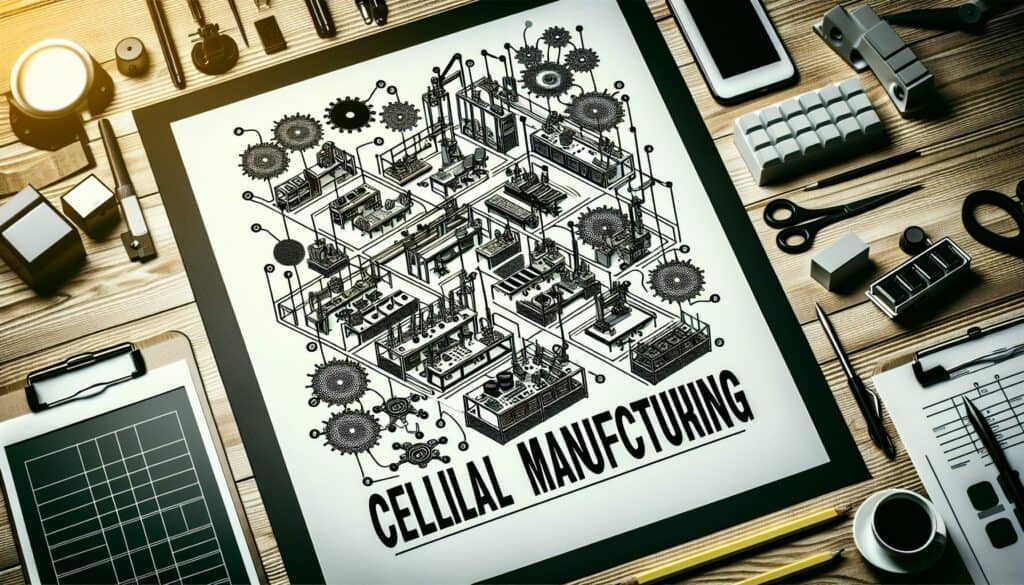To improve production efficiency by grouping dissimilar machines into cells that work on products with similar processing requirements (part families).
- Methodologies: Customers & Marketing, Economics
Cellular Manufacturing

Cellular Manufacturing
- Continuous Improvement, Just-in-Time (JIT), Lean Manufacturing, Process Improvement, Production Efficiency, Quality Management, Value Stream Mapping
Objective:
How it’s used:
- Workstations and equipment are arranged in a sequence to allow for smooth flow of materials and components through the production process with minimal transport and delay. A cell is responsible for manufacturing a family of similar parts.
Pros
- Reduces work-in-process inventory, lead times, and material handling; Improves flexibility, worker morale, and quality; Saves factory space.
Cons
- Can be costly to implement (rearranging equipment, training); Requires careful planning and part family identification; Machine utilization within a cell might be lower if not balanced properly; Vulnerable to breakdowns if a machine in a cell fails.
Categories:
- Lean Sigma, Manufacturing, Product Design
Best for:
- Improving flow and efficiency in high-variety, low-to-medium volume production by creating dedicated, focused production units.
Cellular manufacturing is particularly effective in industries such as automotive, electronics, and appliance manufacturing, where product lines often consist of a variety of components requiring customized assembly processes. This methodology is most beneficial during the design and development phases of new products, where early collaboration among engineers, designers, and production teams can lead to more efficient workflows. The implementation of cellular manufacturing typically begins with a thorough analysis of the product family to identify similarities and group related components, which enables the design of cells that can efficiently deal with variations in production. Participants including production supervisors, quality assurance personnel, and manufacturing engineers are crucial in defining the specific tasks and responsibilities within each cell. This collaborative approach not only enhances communication among team members but also fosters a sense of ownership and accountability, leading to improved worker morale. Furthermore, the layout of the production area can facilitate better ergonomic practices and minimize operator fatigue, which in turn translates to higher quality outputs and lower defect rates. Companies that incorporate cellular manufacturing may use techniques such as just-in-time inventory and lean principles to further enhance productivity, thereby reducing costs associated with excess inventory and prolonging lead times. Continuous improvement initiatives, like Kaizen, are often applied alongside cellular manufacturing, allowing teams to regularly assess and refine their processes to stay competitive in fast-paced markets.
Key steps of this methodology
- Identify the family of similar parts to be produced.
- Design the cellular layout considering the workflow and space efficiency.
- Group equipment and workstations based on the sequence of operations needed.
- Assign team members to specific roles within the cell based on skill sets.
- Implement standardized work procedures for each operation within the cell.
- Establish visual controls and tools to monitor workflow and quality.
- Conduct regular reviews and adjustments based on performance and feedback.
- Train staff on cell operation and encourage cross-training for flexibility.
- Iterate designs and processes based on efficiency metrics and product quality.
Pro Tips
- Analyze process flow regularly to identify bottlenecks and balance workloads across workstations for optimal efficiency.
- Implement cross-training for workers to enhance flexibility, allowing easy movement between tasks and cells as demand fluctuates.
- Utilize performance metrics to assess cell effectiveness continuously, adjusting layout and resources based on real-time production data.
To read and compare several methodologies, we recommend the
> Extensive Methodologies Repository <
together with the 400+ other methodologies.
Your comments on this methodology or additional info are welcome on the comment section below ↓ , so as any engineering-related ideas or links.
Historical Context
1949
1950
1950
1960
1960
1960
1960
1940
1950
1950
1958
1960
1960
1960
1960
(if date is unknown or not relevant, e.g. "fluid mechanics", a rounded estimation of its notable emergence is provided)















Related Posts
METS to Calories Calculator
Meta-Analysis
Message Mapping
Mental Model Diagrams
Maximum Acceptable Pushing and Pulling Forces
Material Requirements Planning (MRP)